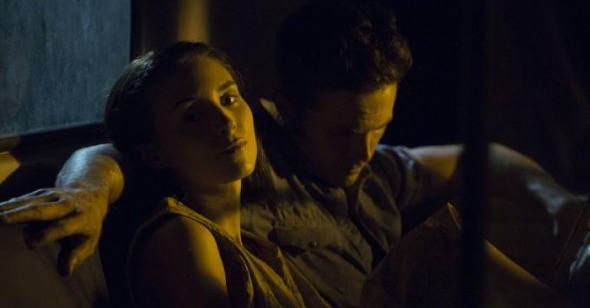Twilight’s Last Gleaming
By Michael Koresky
Ain’t Them Bodies Saints
Dir. David Lowery, U.S., IFC Films
Young filmmakers and critics alike speak of the American seventies cinema with a grandiose nostalgia, as though everywhere one turned there was another masterpiece just waiting to be picked, like a fresh-cheeked apple from an endless orchard. Perhaps if we were all really there, experiencing Wanda and The Last Picture Show and Fat City and Cabaret and Thieves Like Us and The Friends of Eddie Coyle upon first release, as breathing, vital works of art (read: imperfect and wonderfully so) rather than museum pieces propped up as representatives of a different, better era, then we could keep a rational mind when discussing—and emulating—them. When it comes to art, imitation can be the sincerest form of flattering the audience; hence David Lowery’s Texas-set Ain’t Them Bodies Saints, a self-sufficient homage to seventies American cinema that unfolds in the kind of hushed, reverential tones with which we normally speak of that era.
Maybe we need to find new idols. At first blush, Ain’t Them Bodies Saints, a romantic drama about a pair of tragically fated criminals, seems to hit all the right notes, yet those notes are drowned out by loud echoes. The film doesn’t have a sense of place; it has a Sense of Place. It doesn’t offer beautiful natural lighting; it offers Beautiful, Natural Lighting. Right from the opening scene, in which main characters Bob (Casey Affleck) and Ruth (Rooney Mara) fight and then nuzzle in a field at magic hour, something feels off. Check out those perfectly placed lens flares, which might as well be details in a video-game for the studied way they’re placed and held in the frame for just the right seemingly casual effect.
To negatively focus on the cinematography at the outset is both fair and uncharitable. Director of photography Bradford Young is the real star here, more than the naggingly stoic Mara and certainly more than Affleck, whose self-consciously marble-mouthed intonations are as convincingly naturalistic as those flares. A feast of golden dawns, beautifully gloomy dusks, and burnished amber interiors that make entire rooms look like the gorgeously charred husks of a fireplace barely aglow, the film is often visually mesmerizing. Yet too often Young’s work has to do all of the heavy lifting, nestling Lowery’s wisp of a plot in its arms. Young, who also brings a distinctive, aggressive visual approach to Andrew Dosunmu’s upcoming Mother of George, is the film’s key player in persuading us that what we’re watching is of particular import (another is the frequently overlaid score by Daniel Hart, which ranges from ominous to ebullient, with some banjo solos thrown in for good measure). Otherwise the film is all archetypes and no behavioral detail, related with a brooding intensity incongruous to its modest characters and storytelling.
“This was in Texas . . .” an onscreen title card in fanciful storybook font reads at the outset, promising something of mythic proportions. The film soon tidily dispatches with Bob and Ruth’s crime narrative, only briefly dramatizing the aftermath of their presumed spree. Without the specifics of what they did or why, Bob and Ruth aren’t allowed to register as particularly convincing small-time crooks, especially when holed up in an abandoned house having a bloody shoot-out with cops. During this clash, Sheriff Wheeler (Ben Foster) is shot in the shoulder by Ruth, although Bob takes the rap. Years later, upon Bob’s prison bust and attempted journey back to the town of Meridian to see Ruth and the little daughter he’s never met, the effortlessly kind Wheeler has begun to make his own romantic intentions to Ruth clear. Ruth thus ends up caught in an improbable love triangle, between two generally good souls who nevertheless exist on either side of the law.
Perhaps if all three principals weren’t so frequently given to portentous monologues or epistolary voiceover interludes the tragic depths of their romance would feel vital, rather than telegraphed. Rarely do the actors seem like they’ve been given the space to navigate their characters, though the desperate manner in which Affleck and Mara cling to each other as they’re dragged out of the house near the beginning of the film intimates the frayed emotions and richness of feeling that might have been. Even the estimable Keith Carradine (in the seventies an Altman favorite), appearing in a vaguely defined role as a community father figure who takes extreme measures to shield Ruth and the child from Bob upon his escape, is left to play his character by blueprint. In disallowing his characters any idiosyncrasies, his actors, reading their lines in dulcet monotones, can do little more than contribute to the film’s overall soporific quality. It’s certainly a finely honed aesthetic, and in this sense it’s an accomplishment of sustained tranquility, in which the pronounced sound of cicadas on the soundtrack register with more meaning than any of the dialogue.
With its focus on violence amidst idyllic nature and its minor thematic similarities to Badlands, Ain’t Them Bodies Saints has been predictably compared, favorably or not, to the work of Terrence Malick. Yet the correspondence is ultimately dubious. Malick finds his films through the process of making them, which lends them the sense of lightness, of being unfettered from expectation and convention; conversely, Lowery seems to have his film held in a death grip. As it trudges along to a predetermined climax, it’s the sense of discovery—whether in camera, character, or event— that’s finally, fatally missing. The film seems too in awe of its own antecedents to find much to care about in itself. The past cannot be recaptured, only simulated.
